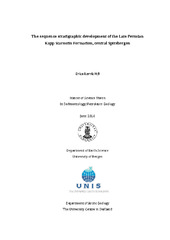| dc.description.abstract | This study investigated the sedimentology and the sequence stratigraphy of the Late Permian Kapp Starostin Formation in the southwestern part of Dickson Land, central Spitsbergen. The underlying Gipshuken Formation and the overlying Triassic Formation, as well as their boundaries to the Kapp Starostin Formation, were also investigated. In the Barents Sea, the Tempelfjorden Group is represented by the Røye and Ørret formations. The measured section in Dickson Land was compared to an age-equivalent spiculitic unit of the Røye Formation from the Loppa High in the Barents Sea. The core section is approximately 50.3 m long and is a part of the reservoir in the Gohta discovery (well 7120/1-3). Fourteen depositional facies have been recognized from the investigated succession in Dickson Land, and another three facies from the core section from well 7120/1-3. The facies have been grouped into 6 facies associations, where FA1 and FA2 comprises the strata of the Gipshuken Formation, FA3, FA4 and FA5 comprises the strata of the Kapp Starostin Formation and FA6 comprises the strata of the Triassic Vikinghøgda Formation. A depositional model with an inner- mid- and outer ramp area is applied for the Kapp Starostin Formation. The inner ramp comprises the intertidal to shallow subtidal areas above the FWWB and is characterized by well-washed and well-sorted sand shoals and shell banks. The mid ramp is the area between the FWWB and SWWB, and was the site of the dominant silica factory of the shelf during the Permian Chert Event. The outer ramp is the area below the SWWB, which was dominated by accumulation of microscleric sponge spicules and siliceous black shale. Based on the facies analysis and the stacking pattern of the facies, three transgressive-regressive sequences were recognized in the Kapp Starostin Formation. Increasingly shallower facies upward in the formation displays the overall regressive development towards the Permian-Triassic boundary. Late Palaeozoic rocks constitute one of the play models in the Barents Sea, and the Permian Røye Formation represents one of the possible reservoir rocks. The main difference between the Røye Formation and the Kapp Starostin Formation was the high degree of dolomitization of the Røye Formation. The karstification and dolomitization is probably due to prolonged subaerial exposure of the Loppa High. | en_US |
